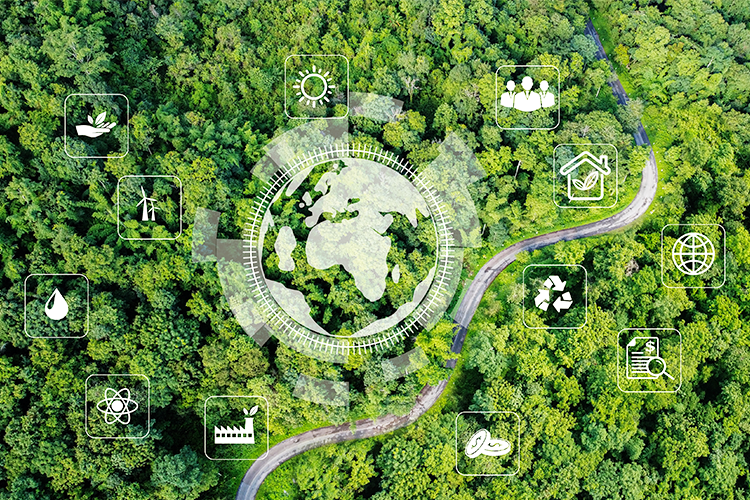Navigating the Sustainability Journey in Business
April 30, 2024
Understanding the significance of sustainability within your business framework is one thing; implementing it successfully is another. While most business leaders acknowledge the importance of sustainable practices, the path to fully integrating these into an organization's DNA can feel overwhelming. With a landscape as broad and complex as sustainability, deciphering where to start, which steps to take, and how to measure success can appear daunting. The challenge often lies not in the recognition of sustainability's value but in navigating the intricacies of its implementation from start to finish.
This part of our series aims to demystify the sustainability journey, offering a clear roadmap for embedding sustainable practices at the heart of your business operations. With this goal in mind, we’ve broken down the multifaceted sustainability journey into two phases:
Phase 1: Laying the Foundation
This initial phase focuses on building the necessary groundwork for a successful sustainability journey. It involves articulating the strategic value of sustainability, identifying internal champions, quantifying the organization's environmental footprint and proactively addressing potential challenges.
- Making the Business Case for Sustainability: This stage focuses on recognizing corporate sustainability beyond environmental benefits, highlighting long-term financial and brand reputation advantages. It also emphasizes setting clear sustainability goals aligned with business priorities.
- Finding Your Internal Sustainability Champions: Key to driving change, this stage focuses on identifying and empowering individuals within the organization who are passionate about sustainability to lead initiatives and inspire others.
- Assessing Current Environmental Impact: Before any meaningful progress can be made, businesses must accurately measure their current environmental footprint to identify areas of improvement.
- Understanding and Overcoming Risks: Implementing sustainable practices comes with its share of challenges and risks. This stage emphasizes assessing these potential hurdles upfront and strategizing to mitigate them effectively.
Phase 2: Incorporating and Communicating Sustainability
This phase centers on embedding sustainability into the core of the organization. It encompasses crafting effective communication strategies, integrating sustainable practices and technologies into daily operations, and ensuring sustainability is a key consideration in decision-making at all levels of the company.
- Developing a Communication Plan: This stage involves crafting strategies to convey the company's sustainability initiatives and goals to internal and external stakeholders compellingly.
- Integrating Sustainability into Operations and Technology: Embedding sustainability into operations and technology involves making it central to daily activities, governance, policies, and strategic planning, especially at the highest organizational levels. It also entails adopting new sustainable practices and technologies to improve environmental and social impacts.
- Measuring and Reporting on Sustainability: To enhance sustainability initiatives, businesses need to accurately measure their efforts' effectiveness using established metrics and create transparent, publicly available sustainability reports for continuous improvement.
In the following sections, we’ll dive deeper into both of these phases, offering insights and practical advice on how you can effectively progress through your sustainability journey.
Making the Business Case for Sustainability
Sustainability transcends mere environmental responsibility. It now stands as a strategic imperative driving long-term profitability and resilience. Companies committed to robust ESG practices can unlock better operational efficiencies, reduced costs and heightened appeal to investors— shaping a resilient and competitive business landscape. While some may harbor doubts regarding ESG investments' financial viability, tangible use cases can serve as powerful catalysts for adoption.
For instance, consider the transformative switch from traditional lighting methods to LED technology. The adoption of LED lighting sees energy consumption plummet by over 50% on average—offering significant reductions in utility costs. This released capital can be redirected towards other crucial areas of business operations thereby amplifying investment capabilities and fostering innovation.
And these advantages are just the tip of the iceberg. Exploring innovative energy-efficient solutions like HVAC UV coil cleaning, fleet electrification and smart building controls unveils further opportunities for returns on investment.
Anticipating the ROI in sustainability becomes less of an enigma when equipped with robust payback calculations and case studies from trailblazing companies. These predictive analyses and real-world examples illuminate the path ahead, often revealing that the move towards sustainable practices is not a leap of faith, but a strategic step grounded in evidence.
Finding Your Internal Sustainability Champions
Champions who advocate for sustainability initiatives cultivate a sense of collective responsibility, bring a wealth of innovative ideas and contribute to a robust culture of sustainability. These individuals, passionate about environmental and social issues, often emerge from various departments and levels. But to find them, you'll need to hold meaningful conversations, solicit feedback and ideas, and create a system of incentives to encourage participation.
Once identified, these sustainability champions can be more effectively engaged through several strategies:
- Empowerment through Responsibility: Let them lead sustainability projects or initiatives, validating their efforts and encouraging proactive change. Include them in planning sustainability strategies or policies. Their unique perspective offers valuable insights not always seen at the executive level.
- Training and Development: Provide opportunities for them to learn more about sustainability through workshops, courses or conferences that match your business’s sustainability goals.
- Recognize and Reward Sustainability Efforts: Publicly recognize their contributions to sustainability projects, motivating them and others through meaningful recognition.
Remember: these champions are hidden gems that will work with you to infuse sustainability into your corporate culture and accelerate sustainability adoption across all levels of the organization.
Assessing Current Environmental Impact
Whether you’re embarking on or enhancing your company's sustainability initiatives, you’re going to need a deep understanding of your environmental footprint. Establishing a baseline is crucial for measuring progress and the effectiveness of your sustainability measures over time.
Conducting an energy audit marks the initial stride in embedding sustainability into your operations. Nonetheless, the caliber of these audits can vary greatly. A thorough audit extends past merely cataloging energy consumption; it carefully documents installed technologies, analyzes lifecycle, pinpoints inefficiencies, and outlines opportunities for enhancement through an in-depth analysis of energy flows.
When choosing a partner for the audit, look for transparency and expertise. Select a company with a solid history in thorough audits and a holistic approach, considering both operational objectives as well as direct and indirect environmental impacts. Asking for case studies or references can provide insights into their effectiveness and approach. The audit should offer clear, actionable steps tailored to your business, with ongoing support to implement these steps and monitor progress.
Understanding and Overcoming Risks
To mitigate risks in sustainability initiatives, a proactive approach is best. Companies should perform regular risk assessments to identify and address any financial, operational, or reputational hazards. Anticipating challenges allows for the development of contingency plans, ensuring stability in sustainability efforts.
For a thorough sustainability risk assessment, businesses need to first pinpoint risks from both internal and external sources. This involves analyzing the sustainability landscape to spot potential risks in areas like supply chains, regulatory compliance, market changes or outdated technology. After identifying risks, assess their likelihood and potential business impact, using both qualitative and quantitative data.
Risk assessments should be dynamic, adapting to the evolving sustainability field. This means regularly updating risk profiles and strategies based on new information, regulatory updates and global sustainability trends. Prioritizing risks helps focus efforts on the most critical areas, making mitigation strategies more effective and efficient.
Developing a Communication Plan
Conveying your sustainability goals and achievements effectively to stakeholders is crucial for maintaining trust and buy-in. Here's how you can approach it:
- Identify Key Messages: Summarize your sustainability strategy's most significant aspects, including your goals, progress, and how these efforts align with your company's values.
- Tailor Communication: Adjust your messaging for different audiences. Employees may need to understand their role in sustainability efforts, while investors might focus on the financial and risk mitigation aspects.
- Leverage Multiple Channels: Utilize various platforms like your company website, social media, press releases and internal newsletters to circulate your sustainability narrative.
- Highlight Real-World Impact: Share stories and data that illustrate the tangible effects of your sustainability initiatives, from reduced carbon footprint to community engagement.
- Encourage Stakeholder Participation: Open channels for stakeholders to ask questions, provide feedback and get involved in sustainability efforts, fostering a sense of community and shared purpose.
Integrating Sustainability into Operations and Technology
Embedding sustainability into the framework of operations and technology is a critical step for companies aiming to make lasting environmental and social impacts. This integration requires a holistic approach, where sustainability is not an afterthought but a key driver of decision-making processes, governance, and strategic planning at all levels, especially at the top.
- Governance and Policies: Develop and enforce policies that support sustainability goals. This includes setting clear guidelines for resource use, supplier selection and product lifecycle management. Ensure these policies align with the organization's overall strategic objectives.
- Strategic Planning: Make sustainability a core component of your strategic planning. This involves setting long-term sustainability goals, identifying opportunities for incorporating sustainable technologies and assessing how sustainability can drive innovation and competitive advantage.
- Adopting Sustainable Technologies: Invest in technologies that improve your company's environmental footprint. This could include renewable energy sources, energy-efficient hardware and advanced materials that reduce waste. Additionally, consider how your company's products or services can be designed or modified to minimize their environmental impact.
By making sustainability a central aspect of operations and technology, companies not only reduce their environmental impact but also realize efficiencies and cost savings, enhance their brand reputation and drive innovation.
Measuring & Reporting on Sustainability
Measuring the success of sustainability efforts involves employing a mix of quantitative and qualitative metrics, tailored to the specific goals and impacts your company aims to achieve. Here are some effective methods:
Environmental Management
- Carbon Footprint Analysis: Calculate the total greenhouse gas emissions caused directly and indirectly by your business.
- Resource Efficiency Metrics: Monitor energy consumption, water usage and waste reduction.
- Regulatory Compliance Tracking: Keep records of adherence to environmental regulations.
Sustainability Performance and Benchmarking
- Sustainability Indexes and Ratings: Participate in recognized sustainability assessments to benchmark your company.
- Supply Chain Sustainability: Ensure alignment with your sustainability standards through audits and certifications.
Social and Stakeholder Engagement
- Social Impact Measures: Evaluate the social impact of sustainability initiatives through Social Return on Investment (SROI) analyses and employee engagement surveys.
- Stakeholder Feedback: Collect and analyze feedback from customers, employees and community members.
To optimize sustainability performance, track key metrics and regularly publish findings in sustainability reports using widely recognized frameworks for ESG (Environmental, Social, and Governance) reporting such as the GRI (Global Reporting Initiative) and SASB (Sustainability Accounting Standards Board) standards. This approach enhances transparency with stakeholders, identifies areas for improvement and effectively communicates progress towards sustainability goals.
Building Sustainability Over Time
While the road to integrating sustainable technologies and practices may seem fraught with challenges, the rewards far outweigh the hurdles. From enhancing brand reputation to achieving significant operational cost savings, the benefits of a sustainability-oriented approach are numerous.
Remember, demonstrating that sustainability is not only feasible but also advantageous is just the beginning of your journey. By starting with manageable actions, you build momentum and confidence. Every action counts, and by taking these first steps, you're contributing to a larger global effort towards sustainability.
Energy Management Collaborative (EMC) manages and scales turnkey energy efficiency solutions for Fortune 500 clients across their North American portfolios. Since 2003, the company has used its total project management approach, EnergyMAXX®, to successfully implement thousands of projects annually including efficient lighting, smart building controls, specialty disinfectant lighting, ROI-driven IoT solutions, electric vehicle supply equipment infrastructure and ongoing maintenance and warranty support. In doing so, EMC has helped clients realize billions of kilowatt-hours of energy savings and advance their net zero emissions goals.


